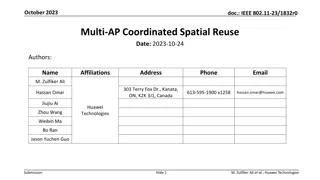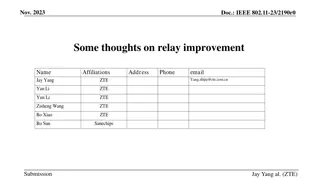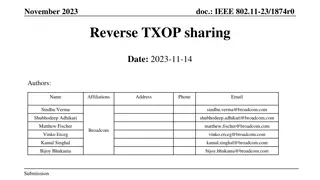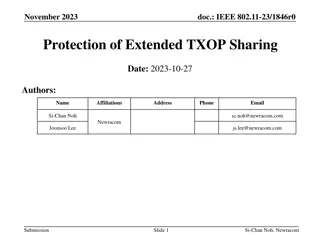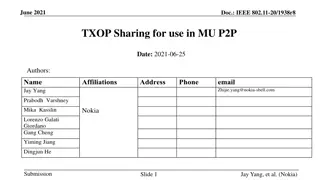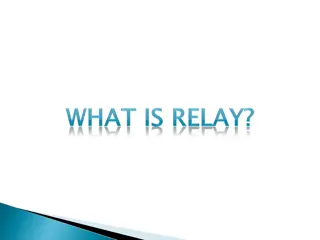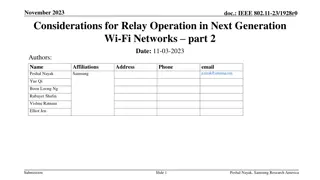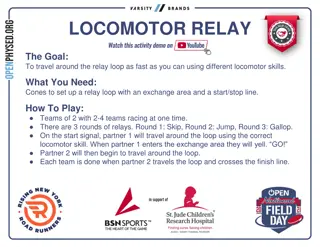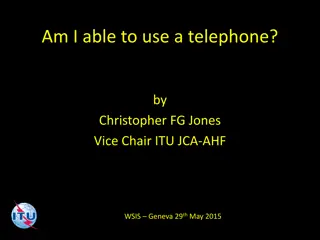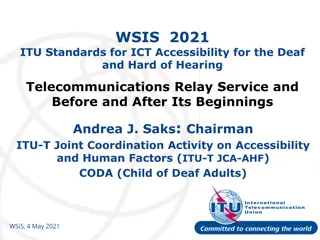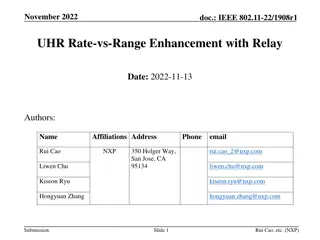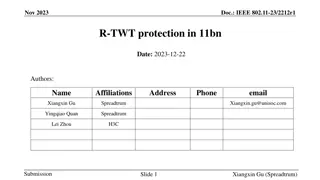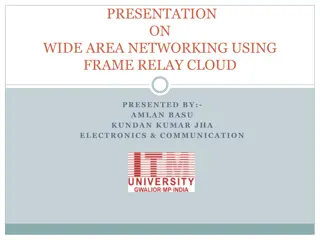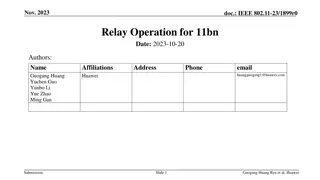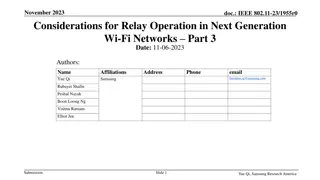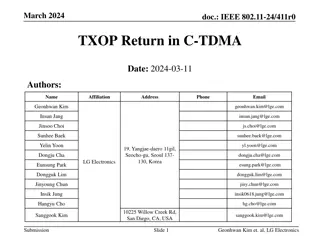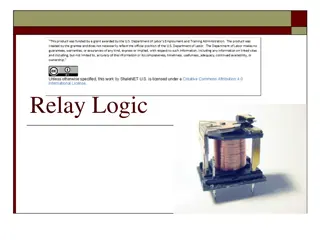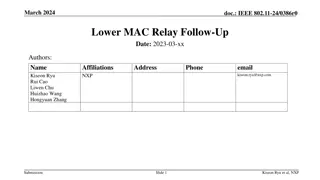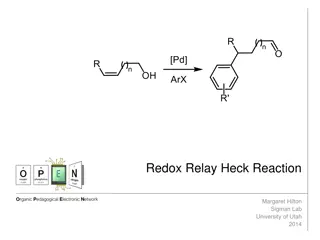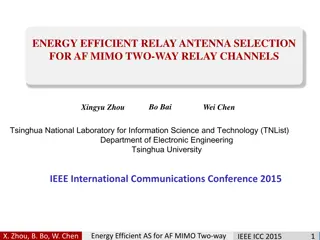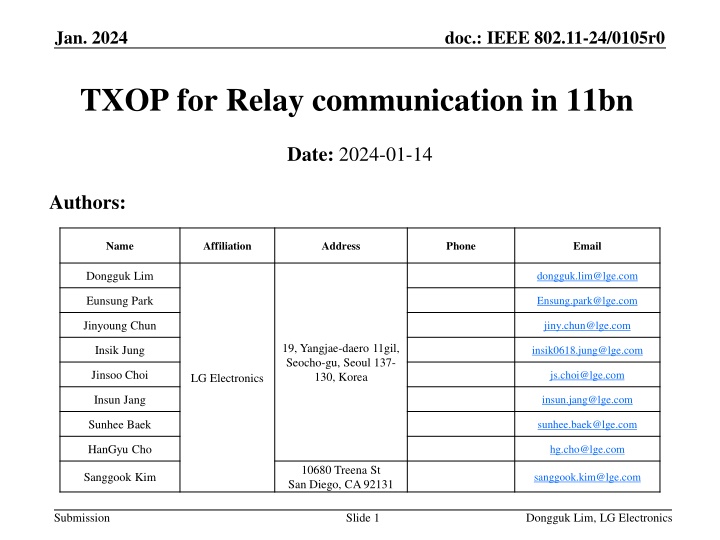
Efficient Relay Communication Methods in IEEE 802.11-24 Standard
Explore how to configure TXOP for relay communication in the IEEE 802.11-24 standard to enhance QoS and extend range efficiently. Discuss the transmission processes between Relay STA, AP, and Destination STA, along with the considerations for reliable and low-latency transmissions. Learn about TXOP sharing for effective relay transmission and the allocation of time within TXOP for relay communication.
Download Presentation

Please find below an Image/Link to download the presentation.
The content on the website is provided AS IS for your information and personal use only. It may not be sold, licensed, or shared on other websites without obtaining consent from the author. If you encounter any issues during the download, it is possible that the publisher has removed the file from their server.
You are allowed to download the files provided on this website for personal or commercial use, subject to the condition that they are used lawfully. All files are the property of their respective owners.
The content on the website is provided AS IS for your information and personal use only. It may not be sold, licensed, or shared on other websites without obtaining consent from the author.
E N D
Presentation Transcript
Jan. 2024 doc.: IEEE 802.11-24/0105r0 TXOP for Relay communication in 11bn Date: 2024-01-14 Authors: Name Affiliation Address Phone Email Dongguk Lim dongguk.lim@lge.com Eunsung Park Ensung.park@lge.com Jinyoung Chun jiny.chun@lge.com 19, Yangjae-daero 11gil, Seocho-gu, Seoul 137- 130, Korea Insik Jung insik0618.jung@lge.com Jinsoo Choi js.choi@lge.com LG Electronics Insun Jang insun.jang@lge.com Sunhee Baek sunhee.baek@lge.com HanGyu Cho hg.cho@lge.com 10680 Treena St San Diego, CA 92131 Sanggook Kim sanggook.kim@lge.com Submission Slide 1 Dongguk Lim, LG Electronics
Jan. 2024 doc.: IEEE 802.11-24/0105r0 Introduction Until the last meeting, we discussed various features and behaviors related to relay operation to provide improved QoS and range extension. To perform the Relay communication efficiently, we should consider the method to guarantee the transmission between Relay STA and Destination-STA. In this contribution, we discuss how to configure TXOP considering Relay communication and what is related to this. Submission Slide 2 Dongguk Lim, LG Electronics
Jan. 2024 doc.: IEEE 802.11-24/0105r0 Relay communication In Relay communication, the Relay STA transmits the signal to an Destination STA after receiving the data from the AP. Therefore, we should consider the both transmission between AP and Relay STA and the transmission between Relay STA and Destination STA(s) in Relay communication. Relay STA AP Destination STA (i.e. Non-AP STA) Submission Slide 3 Dongguk Lim, LG Electronics
Jan. 2024 doc.: IEEE 802.11-24/0105r0 TXOP for Relay communication (1/2) In Relay operation, to guarantee the transmission between Relay STA and Destination STA, Relay communication within one TXOP should be considered. We can consider use of the conventional RTS/CTS frame. Separate from transmission and reception with the AP, the Relay STA received the signal from the AP independently performs RTS/CTS frame exchange for transmission with the Destination STA. For RTS/CTS frame exchange with Destination STA, Relay STA should obtain the channel access through the channel contention with other STAs. However, because the latency for Relay STA's channel access can be long, it is difficult to expect reliable transmission and low latency in Relay communication. In addition, it may require additional signaling between AP and Relay STA because AP can't verify whether the Relay STA has performed the transmission to the Destination STA. AP RTS SIFS Data SIFS ACK Delayed BC=3 BC=1 Relay SIFS SIFS ACK RTS RTS SIFS Data CTS X BC=2 Data Non-AP STA1 Destination STA1 SIFS SIFS CTS ACK Submission Slide 4 Dongguk Lim, LG Electronics
Jan. 2024 doc.: IEEE 802.11-24/0105r0 TXOP for Relay communication (2/2) For the reliable and efficient relay transmission, we should consider the TXOP sharing.[1,2] To protect and guarantee the Relay communication, AP allocates the time within an obtained TXOP to Relay STA for Relay communication. This time information is configured by taking into account the two transmissions (i.e., AP to Relay STA and Relay STA to Destination STA). In addition, the time for the final ACK frame is transferred from the Destination STA to AP through the Relay STA may be included. This time information is shared to Relay STA through the MU-RTS TXS trigger frame transmitting by AP. MU-RTS TXS trigger frame AP SIFS Relay Communication ( AP to Relay STA and Relay STA to Destination STA(s) CTS SIFS Relay STA Since the time for transmission between Relay STA to Destination STA is already allocated by AP, Relay STA does not need to process the channel access for that transmission. Also, in the shared time by AP, Relay STA can transmit and receive the signal with AP and then continuously transmit the signals to Destination STA, enabling efficient and reliable Relay communication within one TXOP. Submission Slide 5 Dongguk Lim, LG Electronics
Jan. 2024 doc.: IEEE 802.11-24/0105r0 TXS Trigger frame for Relay communication (1/3) As a TXS trigger frame for allocating the time for Relay communication, we can consider the following options.[2] Option 1: leverage the MU-RTS TXS trigger frame defined in 11be. As a TXS TF for Relay communication, the MU-RTS TXS TF with Triggered TXOP Sharing Mode subfield value equal to 2 can be considered. It is a simple way and can leverage the frame format defined in the 11be. However, since the transmission from the AP is required within the shared time, to ensure the Relay communication configuring with two transmissions (i.e. AP to Relay STA and Relay STA to Destination STA), the above mode indication as well as an additional indication for Relay communication is required. Therefore, to indicate the Relay communication, additional indication in TXS TF should be defined. The indication may be carried out by using the common info field. For example, some fields reserved in the common field in a MU-RTS trigger frame or bits not used in the common field in the trigger frame may be used to define this information. Submission Slide 6 Dongguk Lim, LG Electronics
Jan. 2024 doc.: IEEE 802.11-24/0105r0 TXS Trigger frame for Relay communication (2/3) Option 2: define a new TXS mode for Relay communication. A new TXS mode for Relay communication can be defined by using the 3 of Triggered TXOP Sharing Mode subfield value as defined with reserved in 11be. In this mode, the signal exchange with AP can be performed. Therefore, it is possible to transmit a signal to Relay STA from AP and exchange the ACK frame through Relay STA between Destination STA(s) and AP. In addition, more than one user field for relay STA and Destination STA(s) can be included in this trigger frame. Triggered TXOP Sharing Mode subfield encoding Triggered TXOP Sharing Mode subfield value Description 0 MU-RTS that does not initiate triggered TXOP sharing procedure. 1 MU-RTS that initiates triggered TXOP sharing procedure wherein a scheduled STA can only transmit MPDU(s) addressed to its associated AP. 2 MU-RTS that initiates triggered TXOP sharing procedure wherein a scheduled STA can transmit MPDU(s) addressed to its associated AP or addressed to another STA. 3 Reserved. MU-RTS that initiates triggered TXOP sharing procedure for relay communication Submission Slide 7 Dongguk Lim, LG Electronics
Jan. 2024 doc.: IEEE 802.11-24/0105r0 TXS Trigger frame for Relay communication (3/3) The TXS trigger frame suggested in previous slides may have more than one user field to indicate the shared time to Relay STA or both Relay STA and Destination STA. The Relay STA and Destination STA can identify the TXOP sharing for Relay communication through the AID subfield of the user field in the TXS Trigger frame. The separate AID value or the AID value in AID12 can be allocated as an identifier of the Relay STA. If the same AID value in AID12 may be used, additional information may be required to distinguish the STA as a role of Relay (i.e. Relay STA may operate as either normal non-AP STA or Relay STA). The Relay STA addressed by the user field in the TXS Trigger frame shall ignore the NAV that is set by AP within the shared time signaled in the TXS Trigger frame after sending the response CTS frame. In UL relay communication, additionally, Destination STA addressed by the user field in the TXS Trigger frame shall ignore the NAV in the above situation. Submission Slide 8 Dongguk Lim, LG Electronics
Jan. 2024 doc.: IEEE 802.11-24/0105r0 BW within TXOP sharing time(1/2) AP and Relay STA have the same primary 20MHz channel within the BSS operating channel width. The operating channel width of the Relay STA is determined through the negotiation with AP. Since AP and Relay STA use the same primary 20MHz channel, the Destination STA does not need to switch channels when it participates in the Relay communication or returns to basic transmission with AP. Relay STA can t use the 20MHz channels that are not covered by PPDU carrying soliciting frame, e.g., MU-RTS TXS. Relay STA follows the conventional rules for MU-RTS Trigger/CTS frame exchange defined in 11be. In addition, Relay STA can use the BW no more than its operating BW for transmitting the PPDU for Destination STA. The punctured 20MHz channel by the AP can t be used by the Relay STA during the shared time allocated by the AP. Submission Slide 9 Dongguk Lim, LG Electronics
Jan. 2024 doc.: IEEE 802.11-24/0105r0 BW in Relay communication (2/2) BW for Relay communication with TXOP sharing For example, AP sends the TXS Trigger frame for Relay communication by using the punctured 160MHz channel. The Relay STA responses with CTS frame on idle channels excluding the punctured channels. The BW including the 20MHz channels that are covered by PPDU carrying CTS frame is used for reception from AP and transmission with Destination STA in terms of Relay STA. According to Destination STA s capability, Relay STA can use the smaller BW than the BW used in transmission with AP. Punctured channel at AP Punctured channel at AP S80 TXS trigger frame TXS trigger frame CCA is BUSY at Relay STA TXS trigger frame ACK (R to A) ACK (D to R) ACK (R to A) CTS TXS trigger frame ACK (R to A) ACK (D to R) ACK (R to A) Data CTS Data (Relay STA to Destination STA(s)) P80 (AP to Relay STA) TXS trigger frame ACK (R to A) ACK (D to R) ACK (R to A) CTS TXS trigger frame ACK (R to A) Relay STA ACK (D to R) Destination STA ACK (R to A) Relay STA 20MHz SIFS CTS SIFS SIFS SIFS SIFS SIFS Relay STA Relay STA AP AP Submission Slide 10 Dongguk Lim, LG Electronics
Jan. 2024 doc.: IEEE 802.11-24/0105r0 Summary In this contribution, to perform the Relay communication efficiently, we consider the use of TXOP sharing by the AP. Since Relay communication is possible within one TXOP, latency can be minimized and the impact of interference on frame exchange between Relay STA and Destination STA can be reduced, thereby ensuring reliability. The BW in TXOP sharing for Relay communication is determined by the conventional rule of the MU-RTS Trigger/CTS frame exchange. In terms of AP and Relay STA, the same Primary 20MHz channel is used for frame exchange. Relay STA uses equal or smaller BW than the BW previously used in transmission with AP for transmission with Destination STA. The same preamble puncturing pattern indicated by AP is used for frame exchange between Relay STA and Destination STA. Submission Slide 11 Dongguk Lim, LG Electronics
Jan. 2024 doc.: IEEE 802.11-24/0105r0 Straw poll 1 Do you support that Relay communication is performed in one TXOP ? One TXOP is configured with the interval of time for both the frame exchange sequence between AP and Relay STA and the frame exchange sequence between Relay STA and Destination STA. The detail of the frame exchange is TBD. Yes No Abstain Submission Slide 12 Dongguk Lim, LG Electronics
Jan. 2024 doc.: IEEE 802.11-24/0105r0 Straw poll 2 Do you support that Triggered TXOP sharing is used for the Relay communication? Wherein AP can transmit MPDU(s) addressed to Relay STA and Relay STA can transmit MPDU(s) addressed to Destination STA. The Details of the TXS trigger frame is TBD. Yes No Abstain Submission Slide 13 Dongguk Lim, LG Electronics
Jan. 2024 doc.: IEEE 802.11-24/0105r0 Straw poll 3 Do you agree the PPDU BW that Relay STA uses for transmission with Destination STA is equal or smaller than the BW used in the preceding PPDU for transmission with AP?? The BW used in transmission with AP is the BW occupied by PPDU carrying the CTS frame. Yes No Abstain Submission Slide 14 Dongguk Lim, LG Electronics
Jan. 2024 doc.: IEEE 802.11-24/0105r0 Straw poll 4 Do you agree that Relay STA uses the same primary 20MHz channel and preamble puncturing pattern with AP in Relay communication? Yes No Abstain Submission Slide 15 Dongguk Lim, LG Electronics
Nov. 2023 doc.: IEEE 802.11-24/0105r0 Reference [1] IEEE 802.11-23/1840r1 Relay for 11bn [2] IEEE 802.11-23/1139r0 Relay transmission in UHR Submission Slide 16 Dongguk Lim, LG Electronics

